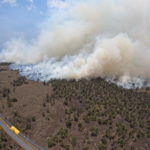Yesterday, officials said the Leilani fire, which has been burning for over a week is 90% contained. The fire burned approximately 17,000 acres of land including areas of Pōhakuloa Training Area and stretches south of Waikōloa Village, the resort area, and mauka of Highway 190 near the Puu Lani Subdivision.
Dozens of firefighters, supported by heavy equipment and air assets, have continued to work to end the blaze. At its most active point the work on the ground was supported by five U.S. Army Helicopters, requested by PTA, HFD’s two helicopters, and a private aircraft contracted by DOFAW.
With the capacity to dip and carry between 80 and 1000 gallons of water each flight (depending on aircraft type) right to where the fire was burning the hottest, the “aerial assets” provide a multitude of other services during a firefight.
“It’s possible, we could see another re-kindle of this fire, as that’s what started it in the first place. The Pōhakuloa Training Area (PTA) federal fire department, first put out a fire here, three-weeks ago. We believe hot spots lay dormant under the ground, and then high winds whipped it up into the major fire, we’ve all been fighting for the past week,” explained Lt. Col. Kevin Cronin, the PTA Commander in a press release.
Steve Bergfeld, an experienced wildland firefighter, and Hawai‘i Island branch manager for the DLNR Division of Forestry and Wildlife (DOFAW), said “DOFAW firefighters, joined by PTA, Hawai‘i Fire Department (HFD) and National Park Service (NPS) teams found it difficult to initially slow the fire due to the high winds, the presence of highly flammable & fire adapted fountain grass, and the difficult terrain and access. We will continue to monitor the fire, but smoldering and unburned pockets of fuel within the firebreaks will continue to burn until we receive adequate rainfall.”
Bergfeld added, “Without a small army of eight private bulldozers, contracted by the State, and one Department of Public Works bulldozer this fire would have grown much larger. The fire lines cut by dozers are intended to remove the fire of fuels, to stop its spread. Most often, line crews then backfire from the firebreaks to further eliminate fuels.
A unified command structure was almost immediately set up to manage the Leilani fire, with command responsibilities shared by leaders from DOFAW, PTA, and HFD. “During a firefight, the agency with jurisdiction takes the lead. This fire was under both PTA and DOFAW jurisdiction. Bergfeld commented, “When it’s burning, our full focus is putting the fire out to protect private property, natural resources, and lives,” he said.
While saying the fire is mostly “contained,” they’re not ready to call it “controlled” just yet. Incident commanders want to be as sure, as they can be, this time the fire is out.
DLNR Photo
